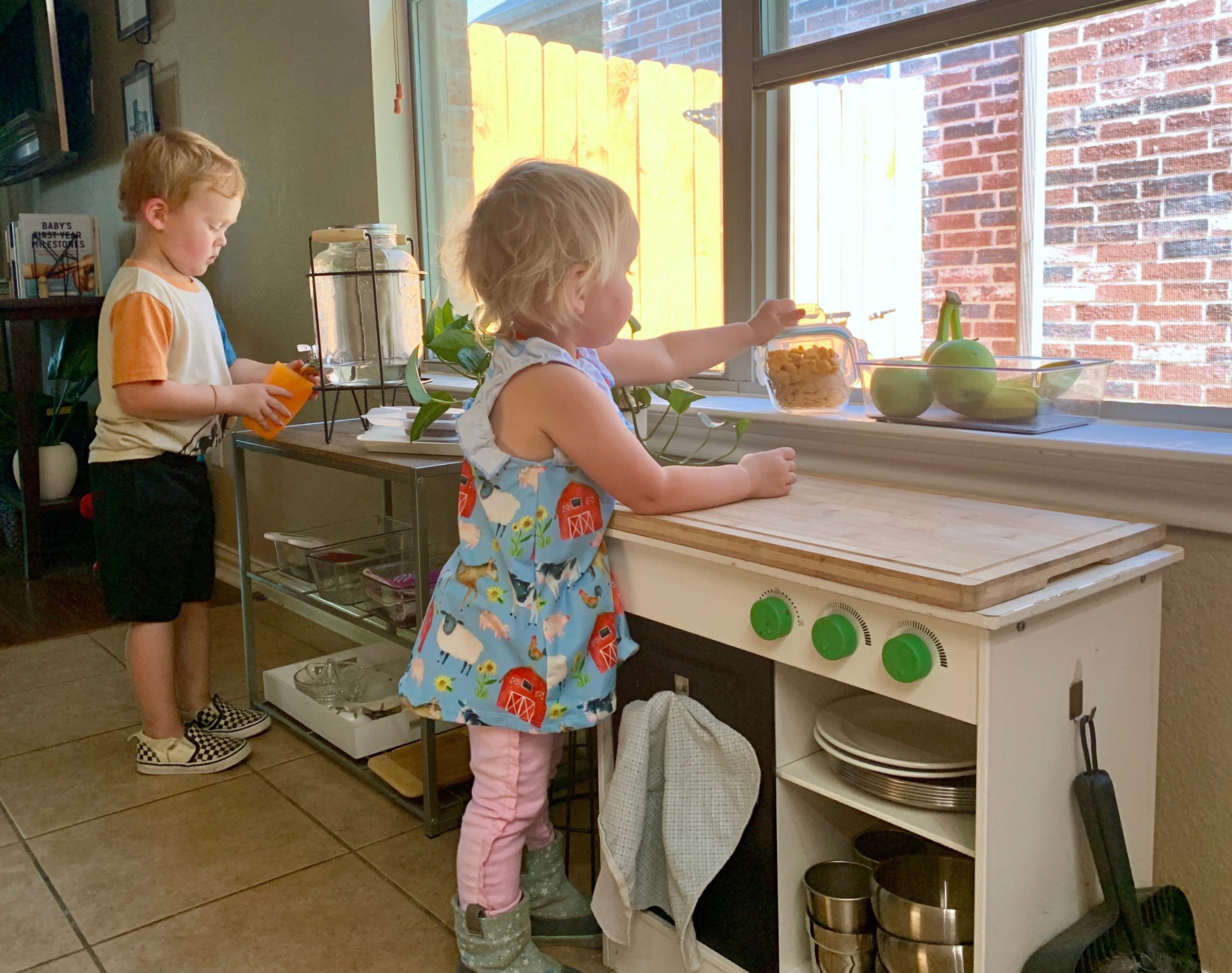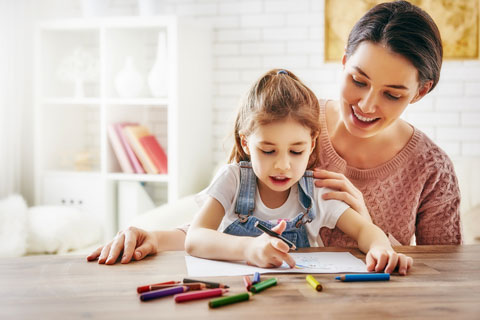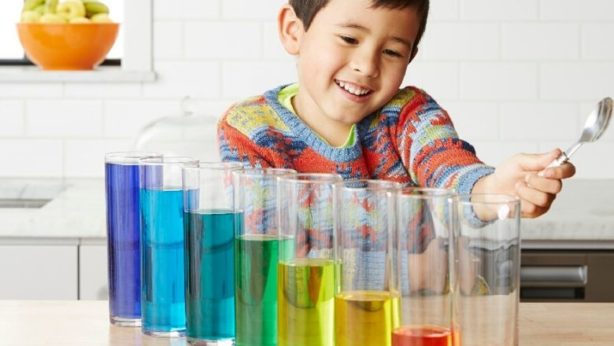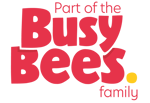Practical Life
Drip, Drop, Drip, Drop . . .
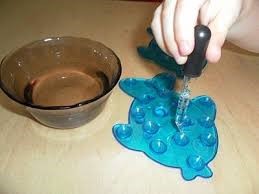
Water is such an interesting substance to work with. In this activity, we’ll use the cohesive ability of water to create ‘bubbles’ that sit on top of suction cups in a soap dish. This is a great activity to develop your child’s fine motor skills! For this activity, you’ll need a suction cup soap dish (the dollar stores still have them), a clean eyedropper (old medicine bottle) and some food colouring. Together with your child, choose the colour of food colouring that you’ll put in the water. Fill the bottle with water and add colour. Show your child how to draw the water up into the eyedropper. Then, show your child how to place ‘bubbles’ of water on the top of each suction cup. After each suction cup has been filled with water, show your child how to clean off the soap dish with a cloth or sponge. Your child will want to do this again, and again . . .
Math Activity
How Much will this Hold?
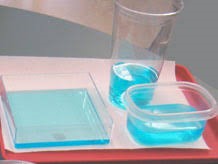
Children love to work with water. This week, water will help them explore the concept of volume. For preschoolers, the concept of two different containers holding the same amount of water is a very difficult one to imagine. You can help your older preschooler to explore this concept. You’ll need: liquid measuring cups, transparent containers in varying heights and diameters and a small pitcher for pouring. You might begin this exploration using two clear containers of different sizes (jars, glass, glass bowl). Begin by filling up a liquid measuring cup to one cup and pour the contents into one container. Then, fill the measuring cup up again, and predict how much of the second container will be filled with the second cup of water. You could also do the reverse. Fill individual containers with water, and then predict how much water is in each container! Make sure you slowly demonstrate how to measure water when using a measuring cup and how to pour from a measuring cup into a container. You can also use this exploration to demonstrate how a person can make connections between questions and observations using a ‘think out loud’ voice (describe your thoughts/questions as you are performing each activity). Explore and compare the volume of liquid that different containers hold. Which holds the most liquid? Which is the ‘trickiest’ container (which container is the hardest to estimate)?
Additional Resources:
Article describing preschoolers and volume exploration (the teacher questions at the end of the article are particularly useful): http://www.eclearningil.org/sites/default/files/hero-resources/microteach_liquid-volume_5-24-16.pdf
Language Activity
The Wind in the Willows

Reading to your child is a valuable and very necessary experience. When you share stories that are rich in vocabulary, you help your child to enrich their vocabulary (the richer a child’s vocabulary is, the more words they know and the easier it will be to decode words when they begin to read). When you discuss the story with your child, it helps them to connect the story to their lives. Why not start reading a ‘chapter book’ at night, before your child goes to sleep? We suggest borrowing a summer classic from your local library- The Wind in the Willows. It’s a story about 4 animal friends who live along a riverbank. While reading the story, stop at words that you think your child might not know, and explain what the word means. Also, use a ‘think- out-loud’ voice while reading. You might ask questions out loud (“I wonder how she will solve that problem?”), make predictions (“I bet that they will . . .”), or clarify (“Let’s find out what that word means”). You can also teach your child how to recap the story (“Do you remember what happened last time?” or “What was x doing the last time we read the story?”). By demonstrating these reading processes out loud for your child, you are teaching them that reading is an active process that goes well beyond just decoding words.
Additional Resources:
The Wind in the Willows Read Aloud (if you can’t find the book): https://youtu.be/AU3L62OomvQ
Read Aloud- Days with Frog and Toad- https://youtu.be/sFVVMhtxtBs
Read Aloud- Frog and Toad Together- The Garden: https://youtu.be/Z-JG_YFmYDk
Read Aloud- Frog and Toad are Friends- https://youtu.be/N8Z6s32YPy4
Read Aloud- Frog and Toad are Friends (Animated film)- https://youtu.be/OWIwUGAJs2U
Sensorial
The Gentle Sound of Rain . . .
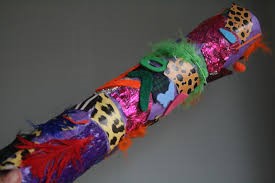
To further engage your child’s sense of hearing, this week you will create a ‘Rain Stick’ together. For this activity, you’ll need: a cardboard tube, small nails, ends for the tube and some sort of grains. In order to determine what kind of grain/seed will be best for your Rain Stick, you’ll need to determine whether you want a soft-sounding Rain Stick or a loud-sounding rain stick. To test out the sounds the different grains/seeds make, you can use a couple of small, empty pill bottles (or camera film canisters!). Place a small amount of one kind of grain/seed in one canister and place the lid firmly on top. Now, gently shake the canister to hear what it sounds like. Then, repeat the same process with another type of grain/seed. Suggested grains/seeds are: rice, quinoa, pot barley. Some people choose to make their rain sticks using a variety of grains/seeds, and some use only one kind. It’s up to you!
Additional Resources:
How to Make a Rain Stick video: https://youtu.be/k0C-K0VxMMk
How to Play a Rain Stick video: https://youtu.be/sXLP6z8B0i4
Making a Rain Stick without nails: https://youtu.be/x-O2EevJmYw
Creative Activity
Bubbles, Bubbles, Everywhere!
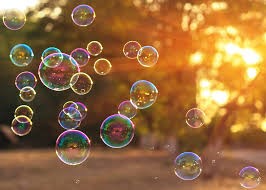
In keeping with our focus on water, this week’s activity is making Bubble Art. For this activity, you’ll need: dish soap, 3 or 4 small bowls with water mixed with food colouring or tempera paint, one straw for each bowl, and, of course, paper. The best kind of paper for this art is watercolour paper because it can absorb the paint without softening and shredding. First, mix soap and colour (paint or food colouring) into each bowl. Then, add with water. After that, choose the first colour that you will ‘paint’ with. Show your child how to blow bubbles in the water. Together, continue to blow bubbles until they overflow the bowl! Place your paper on top of the bowl to capture the bubbles. Then choose another colour and repeat the process. You may capture the new coloured bubbles on a different area of the paper, or you can overlap them with the existing bubbles. When the bubbles pop, they will leave a magical mark behind. This project can go on for as long as your lungs hold out!
Additional Resources:
Making Bubble Art video: https://youtu.be/G88rU8cdTQg
Another idea- popped bubble art: https://www.broogly.com/project/popped-bubble-art








